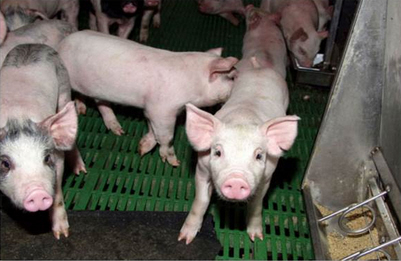



Ample Feeder Space Benefits Slow-growing Pigs in Nursery Phase
Pork producers should consider increasing the feeder space allowance to achieve adequate feed intake by pigs, which can reduce the number of light-weight pigs at market time, according to University of Minnesota researchers, Yijie He, Jerry Shurson, John Deen and Yuzhi Li.Pigs that grow significantly slower than their contemporaries are problematic to pork producers because of animal well-being concerns and reduced profitability. In 'All-In-All-Out' production systems, these pigs do not reach desirable slaughter weights at the same time as their contemporaries, and as a result, they are usually marketed at much lighter weights and consequently return less income to pork producers.
Research studies have shown that social stressors such as competition for feed may have a significant effect on pig growth performance. Slow growing pigs are at a physical size disadvantage to compete with pen mates for feed. This is especially true when pigs are fed together in close proximity to one another, as is the case with most commercial feeders used in production facilities, and as a result, growth performance of slow growing pigs decreases. This situation also raises animal well-being concerns because slow growing pigs are often in a state of hunger, and in some cases, they only feed at night when there is less competition at the feeder.
There is some scientific evidence to suggest that some slow growing pigs in a light weight category are able to overcome slow growth and move up to a heavier weight category at a later production stage, which indicates that it is possible to improve growth performance of slow growing pigs.
The aim of profitable pork production businesses should not only focus on minimising expenses, but also on opportunities to increase income to maximise profits.

At the University of Minnesota's West Central Research and Outreach Center, researchers have evaluated the effects of two different feeder space treatments (standard and ample feeder space) on pig growth performance. Historically, four to 11 pigs per feeder space has been recommended for commercial pork production systems when using a dry feeder with no head barriers between each feeding place. In this study, standard feeder space treatment represented four pigs per feeder space whereas ample feeder space represented 1.6 pigs per feeder space.
Results from this study showed that fast growing pigs and average growing pigs had similar growth performance between two feeder space treatments. However, slow growing pigs provided ample feeder space had improved growth rate during nursery phase compared with slow growing pigs provided standard feeder space.
Several risk factors of being lightweight pigs at marketing were also evaluated including birthweight, weaning weight (26 days of age), nursery exit weight (51 days of age), gender (gilts versus barrows), litter size (less than 14 versus more than 14 pigs born alive per litter) and dam parity (1st parity versus more than 2nd parity).
The factors that had a strong association with pigs being lightweight at marketing were birthweight, weaning weight, nursery exit weight and gender. More specifically, pigs that had light weight at the beginning of each production stage served as a good indicator of being lightweight at marketing. Pigs that weigh less than 3 lbs. at birth, 14 lbs. at weaning, and 44 lbs. at nursery exit were more likely to be lightweight pigs when marketed.
Furthermore, gilts are more likely to become lightweight pigs at marketing compared with barrows.
Finally, litter size at birth and dam parity was not associated with the likelihood of being lightweight at marketing.
Feeder design and access represents the primary factor that can influence whether pigs consume enough of a nutritionally balanced diet to meet their nutrient needs. If diets are not adequately consumed by pigs, growth performance is compromised regardless of nutrient composition.
Based on the results from this study, pork producers should consider increasing the feeder space allowance to achieve adequate feed intake by pigs, which can reduce the number of light-weight pigs at market time.
In addition, identifying poor performing pigs early through close observation on daily basis and providing extra care to further help these pigs would be good exercises.
September 2014








